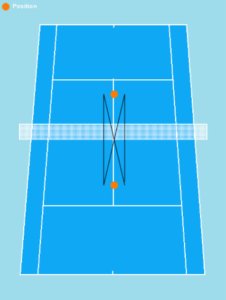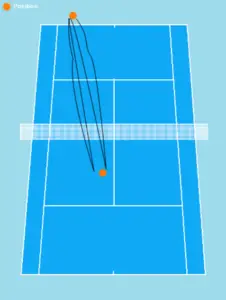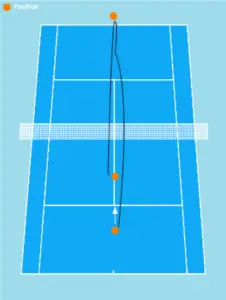Tennis volley exercises
The best 7 tennis volley exercises for beginners
The best 7 tennis volley exercises for beginners
A well-played volley in tennis usually decides matches in doubles, but the volley can also be used profitably in singles. Often, on the basis of a strong forehand or backhand, the way to the net is sought to complete the point.
Therefore, it is advisable to include volley exercises in one’s repertoire after stabilizing the basic strokes. As with all tennis strokes, frequent repetition with the correct volley technique is crucial for beginners to use the volley correctly in matches.
After the completed warm-up program, below we explain to tennis beginners the best 7 volley exercises for beginners. The exercises should ideally be done with a tennis coach at the beginning, so that creeping mistakes can be corrected quickly, but you can also practice without a tennis coach and playing partner.
At the beginning it is recommended to do the volley exercises in the mentioned order – preferably alternating between forehand and backhand volley. With each repetition your confidence will increase and at the next training session you can already start with exercise 3, for example.
If, on the other hand, you feel a little insecure, it is better to go back one exercise. All in all, the exercises can be used flexibly – also for forehand and backhand volley – good luck learning and playing the volley.
1. Volley ball feeling
To increase the feeling for the ball when volleying, both of you stand on one side of the net and each hold up your own tennis ball with an outstretched vertical hand – without the tennis ball bouncing on the ground. After 10 flawless volleys from a standing position, you start to move. For example, you walk along the white lines and hold the tennis ball up again in parallel.
The aim of the exercise is that the ball does not bounce on the ground at any time and that you build up the necessary security – both from a standing position and in the first movement. Repeat the exercise until you feel that you can always achieve the 10 flawless volleys under normal circumstances.
2. Volley on throw
To master the correct volley technique in tennis, you both stand opposite each other on the tennis court with the net in the middle. One person goes to the starting position at the net and the other puts the tennis racket to the side and has a tennis ball in his hand.
Now the tennis ball is thrown from the T-line from below in an arc over the net to the forehand or backhand side of the opposite person. At the beginning it is important to say where the tennis ball is going: “forehand” or “backhand”.
The ball comes flying towards you and you move from the starting position and take the tennis ball as a volley directly out of the air.
The volley should be caught again directly or after bouncing once by the teammate or tennis coach. After 5 balls each on the forehand and backhand side you change and catch the tennis balls.
You can also throw the tennis ball at the teammate’s body so that you can practice a corresponding backhand volley in front of the body.
3. Volley on feed
In this exercise, you will again place yourself opposite the net, with the difference that this time the tennis ball will not be thrown, but hit with the tennis racket.
At the beginning, it is again recommended to announce aloud where the tennis ball will be hit: “forehand” or “backhand”.
The goal is to hit both forehand and backhand volleys into the opponent’s T-field without making any mistakes. After 5 volleys on each side, you alternate between passing and volleying.
To increase the level of difficulty, you can also omit the forehand and backhand announcements and play the ball carefully in the direction of the body.
4. Volley on the ball wall
To increase the number of volleys played, the ball wall has excellent. If your club does not have a ball wall, you can use any other wall.
You stand in front of the wall at a short distance and play the tennis ball from your hand with your forehand against the wall. Now play as many volleys as possible without bouncing the tennis ball.
Vary the volleys again between forehand and backhand volley – always start with the slightly easier direction, i.e. longline.
The goal is to play at least 10 error-free volleys. If this is still too difficult at the beginning, move closer to the ball wall to shorten the distance.
5. Forehand and backhand volley
Back on the tennis court, line up across from each other again in the T-court and one person forehands the ball and then you start playing volleys back and forth.
Set up at the beginning so that you can play forehand and backhand volleys longline to each other. Only then switch to the cross variant.
The goal of the exercise is that you play at least 20 error-free volleys in total, i.e. everyone plays 10 error-free volleys back and forth. To further increase the difficulty, one person can play only longline and the other only cross. After 2 minutes, the game is changed accordingly.

6. Volley on baseline stroke
If you feel safe for short-range passes, the attacker can slowly move across the 3/4 court to the baseline. From there, the ball is now played with increased speed, but from a greater distance, with the forehand or backhand.
The volley is played directly back to the opponent, so that a ball change is simulated. The server from the baseline can also stand in his own forehand and backhand side from the middle position, so that volleys can be practiced longline as well as cross on both sides.
The aim of the exercise is to simulate a ball change – after a few passes, the position is changed: the previous volley player moves to the baseline and the baseline player moves to the net.

7. Volley on the run
Here, one player stands at the baseline and the other behind the T-line. The player behind the T-line plays the ball into the forehand or backhand side and then advances to the net in the T-field.
The player on the baseline hits the ball back and the player on the way to the net may get a volley under net edge – especially difficult – to play and the point is played out.
The goal is to simulate the transition from a good baseline shot to the net.
Again, it is a good idea to switch sides after a few passes so that the advancing player goes to the baseline and vice versa.



